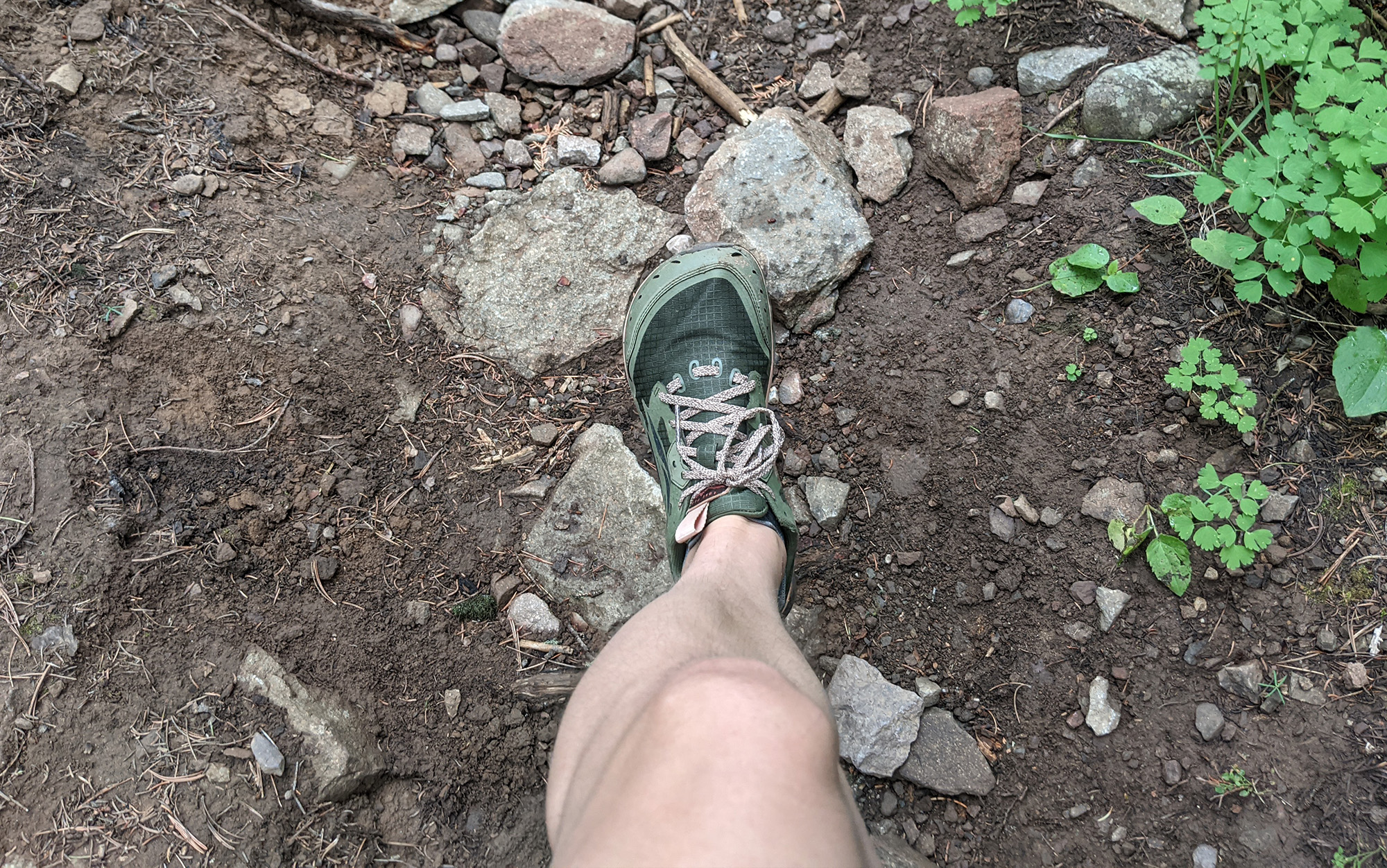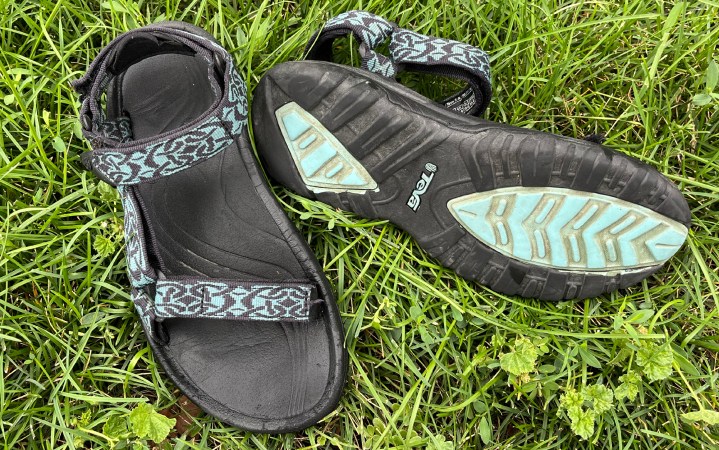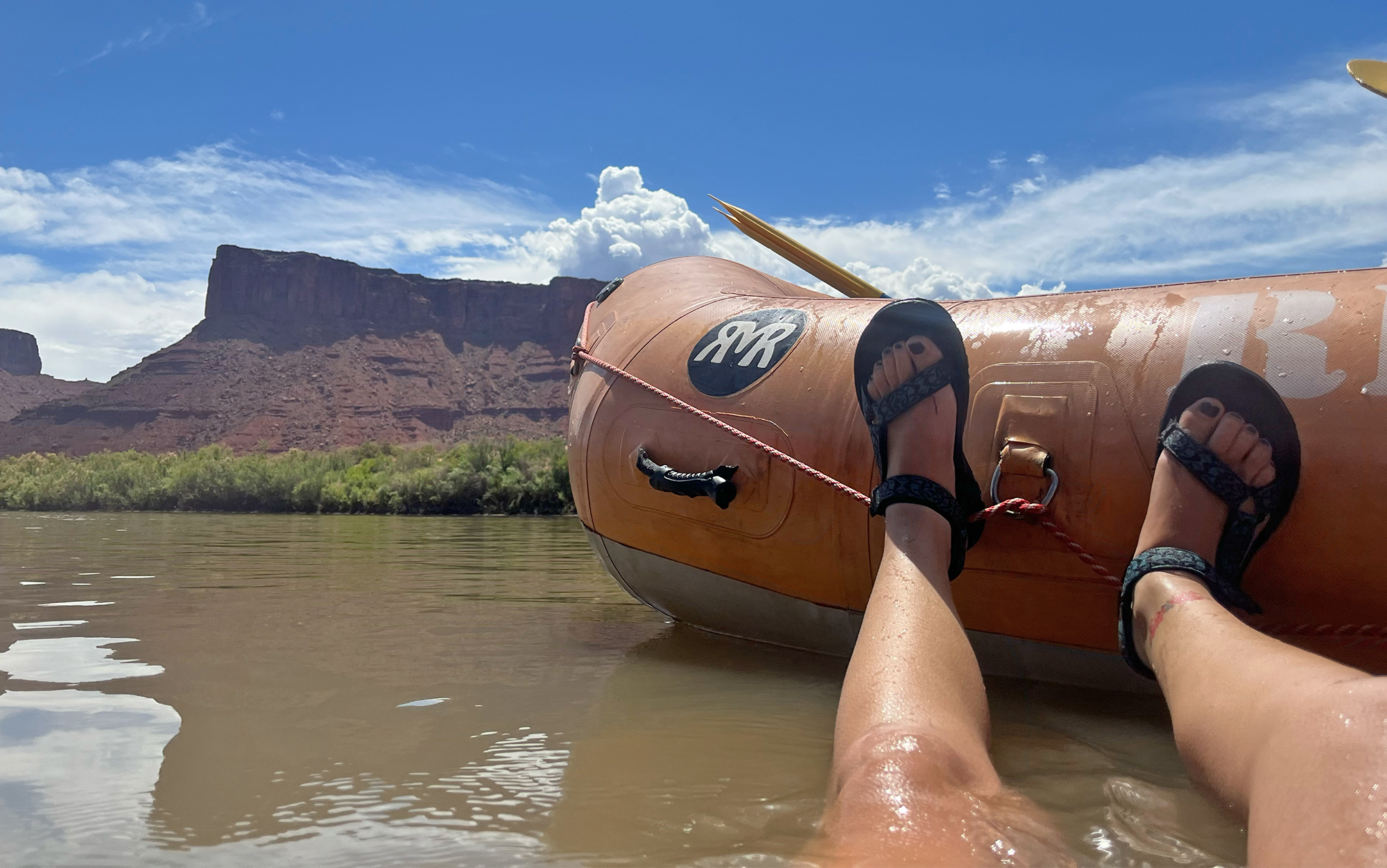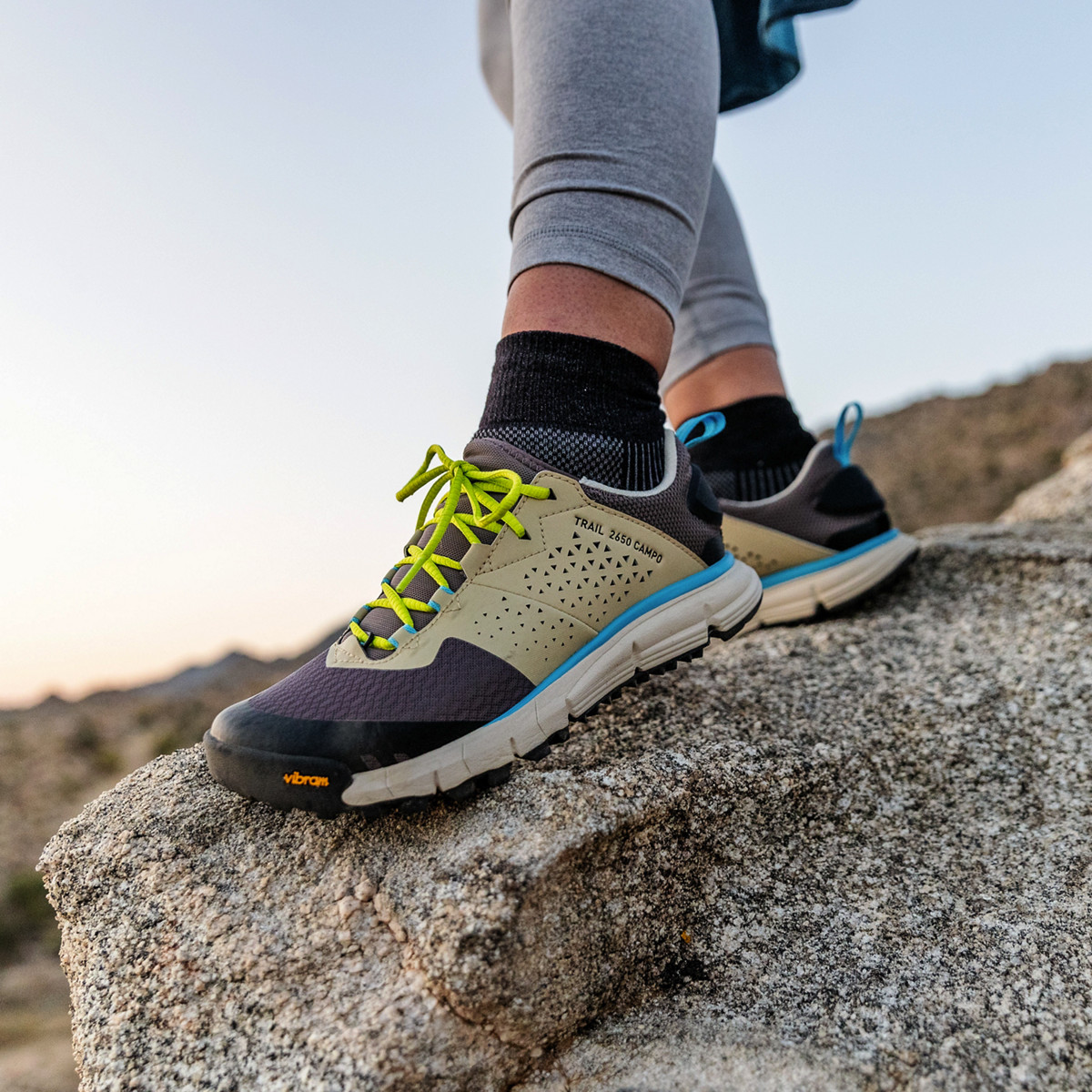We may earn revenue from the products available on this page and participate in affiliate programs. Learn More ›
In recent years, the line between hiking shoe and trail running shoe has blurred, with more and more day hikers, and even backpackers, opting for the latter. Today, there are options ranging from durable shoes with similar ground protection of the best hiking boots to lightweight shoes that border on minimalist trail runners. To find the best hiking shoes on the market, I talked to a variety of individuals, from staff here at Outdoor Life to long-time gear testers to members of the Colorado Mountain Club.
Best Trail Runner: Altra Lone Peak 8 (Men’s) (Women’s)
↓ Jump to Review
Best Traditional: Oboz Katabatic Low Waterproof (Men’s) (Women’s)
↓ Jump to Review
Best Hybrid: Danner Trail 2650 Campo GTX (Men’s) (Women’s)
↓ Jump to Review
Most Comfortable: Hoka Speedgoat 5 (Men’s) (Women’s)
↓ Jump to Review
Best for Beginners: Merrell Moab 3 (Men’s) (Women’s)
↓ Jump to Review
Best Barefoot: Vivobarefoot Primus Trail FG (Men’s) (Women’s)
↓ Jump to Review
Best Sandal: Teva Hurricane XLT2 (Men’s) (Women’s)
↓ Jump to Review
Best Water Shoe: KEEN Drift Creek H2 (Men’s) (Women’s)
↓ Jump to Review
Best for Camp: Merrell Hydro Moc (Men’s) (Women’s)
↓ Jump to Review
How We Chose the Best Hiking Shoes
Since body types, foot structures, and overall preferences differ so much, it can be difficult to ascertain what the best hiking shoe is in any one category, especially if you prefer a different style altogether. Years ago, I tested the Brooks Cascadia (my top pick for trail running shoes and a long-time thru-hiker favorite) and found that its 26mm/18mm stack made for uncertain footing after years of running in a zero-drop minimalist shoe. But my experience in no way counteracts the positive experiences of others — I just prefer a different style of shoe.
For that reason, I considered the opinions of many different hikers and backpackers, including the OL gear team and contributors, thru-hikers (including gear tester and thru-hiker Pam Himstedt), and members of the Colorado Mountain Club — in addition to plugging my own favorite hiking shoe, the Vivobarefoot Primus FG). These individuals span a wide range of preferences and activities, and their insights provide solid choices, backed by years of on-trail experience for each category. I have also included top picks from OL’s tests of the best lightweight hiking shoes, best hiking shoes for beginners, best barefoot shoes, best hiking sandals, best camp shoes, and best water shoes for hiking.
Best Hiking Shoes: Reviews & Recommendations
Best Trail Runner: Altra Lone Peak 8
Men’s Sizes
Key Features
- Weight: Men’s: 21.4 ounces, Women’s: 18.3 ounces
- Stack height: 25mm
- Heel-to-toe drop: none
- Lug height: 6mm
- MaxTrax outsole
- Available in regular
Pros
- Wide toe box increases stability
- Substantial lugs for improved traction
Cons
- Rock plate can inhibit ground feel
- Heel doesn’t lock in as securely
The Altra Lone Peak 8s combine the best features of responsive trail running shoes with the serious bona fides of a true hiking shoe. This shoe is a great choice for everything from long distances to day hikes to trail runs. It starts with a zero-drop in the stack height (meaning there’s no height difference between the front of the shoe and the back of the shoe), which promotes striking on the midfoot. Yet, they still provide enough cushion for committed heel strikers. The Lone Peaks also have an unusually wide toe box that allows your toes to splay as you hike, improving ground feel and promoting stability.

To protect the foot from sharp rocks and other trail hazards, the midsole is equipped with comfortable cushioning and a solid rock plate. One OL staff member was impressed by the substantial lugs on the Lone Peak 6, which performed well on a steep pass covered with wet leaves, “I felt in control even in the moments I slowed down out of caution,” they said. Read the OL Gear Team’s full review: Altra Lone Peak 6 Review: We Put the Best Hiking Shoe to the Test.
Best Traditional: Oboz Katabatic Waterproof Low
Men’s Sizes
Key Features
- Men’s and women’s specific models
- Weight Per Shoe: 12.7 ounces (men’s), 9.8 ounces (women’s)
- Available Sizes: 8-14 (men’s) and 5-12 (women’s)
- Four color options
Pros
- Non-waterproof and waterproof options ($20 more)
- Mid-ankle option available
- Breathable mesh
Cons
- No wide options
- Not a Vibram outsole
- Weight
OL contributor Justin La Vigne picked the Oboz Katabatic as his top lightweight option, despite having never used it prior to running a test of the best lightweight hiking shoes. Here’s what he had to say: To be honest, this was my first time trying Oboz. I hear so many people rave about the brand, the quality, and the comfort, but I finally tried out the Katabatic Lows to see about the hype. What did I discover? Out-of-the-box comfort and no rub spots after over 100 miles. The unique construction of abrasion-resistant, breathable mesh with plastic rubber molds the shoe around the foot for better protection and support. “They are the only company that adds a molded hard plastic insole to their shoes for real arch support that will not quickly squish down under pack weight or a foot that habitually overpronates. It’s like getting aftermarket insoles for free in every pair,” Kim Kelley, a member of REI’s virtual outfitting team, says.
While they don’t utilize a Vibram outsole, Oboz does have their own Trail Tread, which has an aggressive multidirectional lug pattern comparable to Vibram outsoles. I always kept my grip, even on wet, rocky, and rooted trails. Its relatively low heel-to-toe drop of 8mm gives a nice sense of stability to this shoe as well.
Green bonus: They are designed in Bozeman, Montana, and Oboz will plant a tree for every pair of shoes sold.
Best Hybrid: Danner Trail 2650 Campo GTX
Men’s Sizes
Key Features
- Weight: Men’s: 24 ounces, Women’s: 19 ounces
- Stack height: 32mm
- Heel-to-toe drop: 8mm
- Lug height: 4mm
- Vibram 460 outsole
- Gore-Tex option
- Available in regular and wide
Pros
- Great fit
- Protects the foot like a traditional hiking shoe
- Fast break-in period
Cons
- Heavier than a typical trail runner
- Substantial heel-to-drop promotes heel striking
It can be tough to transition from the durability and secure fit of a heavier hiking boot or hiking shoe to lightweight trail runners, which aren’t always built for the heavy loads some backpackers carry. In preparation for an upcoming thru-hike, one tester took the Danner Trail Campo 2650 GTX on a series of day hikes that totaled fifty miles around Land Between the Lakes in Kentucky. She found that the integrated tongue of the shoe improved the overall fit, locking her heel into place and giving her the stability she was accustomed to from hiking shoes. Strategically placed leather panels on the upper also helped protect her toes and Achilles area, while the ventilation in the Gore-Tex kept her feet from overheating. But they were more akin to trail runners when it came to comfort, “I did not have to break them in at all—they felt great on the first hike,” she reported.
Alex Murphy, in his look at the best men’s hiking shoes, also found the Campo’s a versatile choice. Here’s what he had to say: The first thing I noticed with the Danner Trail 2650 is they look cool. I have a pair of blue ones, and they look like you can wear them just about anywhere. Aside from looking the part, Danner also uses the Vibram sole for great grip. While the actual shoe is thin and breathable, I found it had extra reinforcement where you need it, like on the toe box, which is helpful on rocky trails. The GORE-TEX material also helped keep my feet dry from outside water while allowing for breathability and avoiding sweaty feet. I would recommend sizing down these men’s hiking shoes in some cases as I felt a little bit of wiggle room, especially around the heel.
Most Comfortable: HOKA Speedgoat 5
Men’s Sizes
Key Features
- Weight: Men’s: 20.6 ounces, Women’s: 17 ounces
- Stack height: 32mm
- Heel-to-toe drop: 4mm
- Lug height: 5mm
- Vibram Megagrip outsole
- Gore-Tex option
- Available in regular and wide
Pros
- Comfortable
- Improved stability from previous models
- Excellent traction in wet, slippery conditions
Cons
- Can feel heavy
- Narrow toe box doesn’t allow the foot to splay naturally
The substantial cushion on the Hoka Speedgoat 5 will catch your eye immediately. This feature makes this shoe the go-to for a wide range of people, from day hikers to trail runners to thru-hikers. But the stack height belies the mild heel-to-drop on this shoe, which promotes a mid-foot strike (as opposed to a heel strike), which lessens the impact on the rest of your body—especially if you’re carrying a heavy load down a steep trail.
Compared to previous versions of the Speedgoat, the 5s have slightly less cushion but are substantially more stable. An OL staff member noted that, in combination with the Vibram outsole and 5mm lugs, these shoes were excellent on their state’s varying terrain. Whether backpacking or trail running, “from solid trail to steep skree fields…my foot felt secure and supported,” they said.
Best for Beginners: Merrell Moab 3
Men’s Sizes
Key Features
- Weight: 1 pound 10 ounces
- Drop: 11.5mm
- Lug: 5mm
- Merrell Air Cushion heel
- Vibram TC5+ outsole
- 100 percent recycled laces and webbing
- Available in a waterproof version
Pros
- Comfortable
- Durable
- Good for wider feet
Cons
It’s no surprise that the Merrell Moab 3 was a favorite of Colorado Mountain Club members for low-priced hiking shoes, and it was also Associate Editor Ashley Thess’s pick for the best hiking shoe for beginners. For many people, including those with wide feet, it’s a comfortable hiking shoe from day one that doesn’t result in blisters. And the combination of suede leather and mesh will stand up to tough trail conditions. This is a hiking shoe that you can expect to own for several years without any issues.
Read Next: Best Hiking Shoes for Beginners
Like many hiking shoes, the Moab 3 is heavy, and has a substantial heel drop, especially if you’re used to wearing lightweight tennis shoes. Your ankles may feel more fatigued more quickly in this shoe. It’s also designed to accommodate heel strikers, which is common but something to keep in mind if you typically have a mid-foot strike.
Men’s Sizes
Key Features
- Weight: Men’s: 18.4 ounces, Women’s: 15.7 ounces
- Stack height: 6.5mm
- Heel-to-toe drop: none
- Lug Height: 4mm
- Firm ground outsole
- Available in regular only (although they run wide)
Pros
- Short stack height and zero heel drop make this a true barefoot shoe
- Durable lugs and reinforced upper
Cons
- The upper requires some break-in
- Does not provide as much ground feedback as others
Most minimalist trail runners are breezy, barely-there affairs, with only the thinnest membrane between your feet and the ground. And while that works well for low-key trail runs, the Vivobarefoot Primus FG can tackle more challenging backcountry conditions like slickrock, volcanic pumice, or the scorching desert floor at midday.
I wore these on a thru-hike of the Colorado Trail and was impressed by their durability. At the end of the trip, there were no holes in the upper and the seam at the feather edge was intact. While the lugs were worn to a nub at the forefoot, there were no significant signs of wear on the outsole itself. Despite being on the heavy side (although still substantially lighter than a standard trail runner), the Primus FG still performed like a minimalist shoe and promoted a mid-foot to forefoot strike that kept my foot low enough to the ground to negate any concerns of ankle roll. They also dried fast after stream crossings.
One word of caution is that this shoe should only be worn on the trail by people already accustomed to minimalist footwear, as an undeveloped arch is at risk of developing plantar fasciitis without the support of a standard trail runner or hiking shoe.
Read Next: Best Minimalist Hiking Shoes and Trail Runners
Best Sandal: Teva Hurricane XLT2

Men’s Sizes
Key Features
- Weight: 1 pound, 2 ounces
- Hook-and-loop closure
- EVA footbed
- Nylon shank
- Rubber outsole
- Recycled polyester webbing
- Life Naturals anti-odor
Pros
Cons
I’m on my second pair of Tevas and they’re my favorite hiking sandals. At 18 ounces they’re lightweight enough to backpack with as camp shoes while also providing the support and traction necessary to hike around once you’re ready to ditch your sweaty boots or trail runners. The nylon shank that supports your arch is flexible and great for anyone with low to medium arches. These have a roomy fit with plenty of toe splay and I love the lightweight feel when scrambling over rocks or trudging through deep sand. I backpack with these frequently in wet or sandy conditions, even 19 miles in a day.

The rubber outsole and deep lugs add protection and grip for stream crossings. However, they are typically still damp by the time I get to camp because they take a while to dry. The hook and loop closure make them easy to adjust, take off, and put back on quickly. You can also incorporate socks or neoprene booties if necessary. Once your Tevas have finally bit the dust, you can recycle them through the TevaForever program instead of sending them to a landfill.—Ashley Thess
Read Next: Best Hiking Sandals
Best Water Shoes: KEEN Drift Creek H2
Men’s Sizes
Key Features
- Weight: 1 pound per pair
- Available Sizes: Men’s 7-15; women’s 5-12
- Runs true to size
Pros
- Reasonably priced
- Great drainage
- Comfortable
- Secure fit
Cons
- Not enough protection for the most treacherous stream crossings
If you spend a lot of time in the water and want a shoe that can transition easily from a lazy paddle to a fast-moving day hike, then the KEEN Drift Creek H2 is the shoe for you. The relatively low stack height of this shoe means it had good stability on uneven surfaces and surprisingly good traction for a hiking sandal. But what stood out the most with the Keen Drift Creek H2 was its drainage. Not only did water clear out of the shoe almost as soon as I got to shore, but it was also easy to clear out any sand or pebbles by giving my foot a gentle shake in the water.
Read Next: The Best Water Shoes for Hiking
The downside of this design is that it means you have less protection overall from objects in the river itself (although the Drift Creek H2 does have robust toe protection, unlike most hiking sandals). Most of the time, this won’t be an issue, but if you plan to do extensive hiking in fast currents or murky water, you’d be better off going with either the Salomon Tech Amphib 4 or La Sportiva TX Canyon.
Best for Camp: Merrell Hydro Moc
See It
Key Features
- Available Sizes: Men’s 7-15, women’s 5-11
- Materials: Injected EVA foam
- Weight: 14.6 ounces
- Moderate arch support
Pros
- Comfortable
- Affordable
- Can be used for river crossings
Cons
This is the do-it-all camp shoe. First off, it’s comfortable and roomy. At the end of the day, when your feet have been banged up by a full day of backpacking, the smooth, cushioned sole of these shoes, coupled with its wider-than-usual interior will feel good to your feet. They are easy to slip on and off, a boon during that midnight bathroom break. The inclusion of a true back heel (unlike the Crocs Classic) makes the Merrell Hydro Mocs secure enough for all but the gnarliest river crossings. (Indeed, it was the winner of our best camp shoe award when we tested the best water shoes for hiking.)
They are even affordably priced, one of the few camp shoes we looked at to come in at well under $100. And you can feel good about their eco bonafides, as 10 percent of the shoe is made from Bloom, a foam derived from algae. The algae was harvested from waterways around the world where an excess in algae (which can occur as a result of both rising temperatures and agricultural runoff) has the potential to result in toxins entering waterways.
Read Next: Best Camp Shoes
Things to Consider Before Buying the Best Hiking Shoes
To learn more about how to choose between hiking boots, hiking shoes, and trail runners, I chatted with Kim Kelley, a member of REI’s virtual outfitting team. Here’s what I learned:
Hiking Boots, Hiking Shoes, or Trail Runners?
The choice between hiking boots, hiking shoes, and trail runners is a matter of personal preference. Some like the secure fit of a hiking boot, while others prefer the more athletic feel of a trail runner. Still, others are looking for something in-between. A hiking shoe can provide a nice mixture of the foot and ankle support of a hiking boot with the lightweight, athletic profile of a trail runner. At the end of the day, the choice is about what’s most comfortable for you.
Ankle Support
It turns out that the upper of a hiking boot does not help prevent ankle rolling—it’s actually the firmness of the base that does this. If you’re thinking about switching to a hiking shoe from a hiking boot, you can test this by trying to twist the base of the shoe. If it moves, it won’t provide as much ankle support.
Arch Support
On long hikes or backpacking trips, it’s common for the arch of the foot to become fatigued, which can lead to plantar fasciitis. A common cause of this, especially among day hikers and backpackers, is overpronation, where the foot leans or collapses inward. Anyone experiencing this, or suffering from pain while they walk might benefit from an insole like Superfeet (individuals with exceptionally strong arches may prefer a Currex insole).
Read Next: Best Insoles for Hiking
Shoe Size
With hiking shoes, it’s important that there’s some space between your toes and the end of the shoe—aim for about a finger’s width of space between the end of your toes and the tip of the shoe. For most people, that will work to about a half size larger than they typically wear. However, Kelley cautions that many people, especially women, rely on shoe sizings that they received when they were younger, and don’t take into account the natural growth of the foot over time. Also consider if you need wide hiking shoes. Getting your foot sized by a professional—something you can do through REI’s Virtual Outfitting without visiting a store—is an important part of choosing a hiking shoe.
Traction
Traditionally, one of the most important differences between trail runners and hiking shoes was the size of the lugs. But today, there are a number of trail runners on the market with substantial lugs that mirror the functionality of traditional hiking shoes or boots.
Durability
One important difference between hiking shoes and trail runners is durability. Hiking shoes typically last for 500 to 700 miles, while trail runners only last 300 to 500 miles. Factors that can affect this include the durability of the rubber, the sole, the midsole, and the uppers (leather vs. mesh), as well as the weight of the person wearing the shoes and the conditions they frequent.
FAQs
If you love your running shoes, wear them everywhere, and are comfortable in them, then yes, you can absolutely wear your running shoes hiking. If you’re heading out on a particularly technical trail, where there’s potential to slip or loose your foot on a steep slope, it’s worthwhile to check out the lugs on the underside of your shoe—if the lugs are worn off, or insubstantial to begin with, you may want to look into buying a new pair.
Hiking shoes should be locked in at the heel, but then loosen up as the foot moves forward. If the balls of your feet feel constrained or your toes are unable to splay (inhibiting shock absorption) then the shoe’s volume is too small for your foot. One option to increase the volume of the shoe is to take out the insole.
A rock plate is a hard, thin membrane that doesn’t flex, inserted inside of the shoe, that stops hard or pointy objects from penetrating the shoe and injuring the foot. However, rock plates do inhibit ground feel, or your foot’s ability to react to rocks or roots on the trail, which can impact other parts of the leg or foot.
Trail runners and hiking shoes both cost in the neighborhood of $100 and $200. However, keep in mind that hiking shoes typically last longer than trail runners.
Final Thoughts on the Best Hiking Shoes
With so many options to choose from—and just as many strong opinions about their pros and cons—it can be daunting to choose the best hiking shoes if you’re new to the market. Keep an open mind, but also consult your own preferences. Do you value comfort above all else? Are you nervous about navigating rocky or rooty trails? Are you prone to blisters, or do you rarely get them?
My advice: if you find a pair of shoes that works perfectly for you, buy multiple pairs if you can. Shoe manufacturers are forever tweaking their different models—the perfect shoe one year may not work for you when a new model is released.
Best Trail Runner: Altra Lone Peak 8 (Men’s) (Women’s)
Best Traditional: Oboz Katabatic Low Waterproof (Men’s) (Women’s)
Best Hybrid: Danner Trail 2650 Campo GTX (Men’s) (Women’s)
Most Comfortable: Hoka Speedgoat 5 (Men’s) (Women’s)
Best for Beginners: Merrell Moab 3 (Men’s) (Women’s)
Best Barefoot: Vivobarefoot Primus Trail FG (Men’s) (Women’s)
Best Sandal: Teva Hurricane XLT2 (Men’s) (Women’s)
Best Water Shoe: KEEN Drift Creek H2 (Men’s) (Women’s)
Best for Camp: Merrell Hydro Moc (Men’s) (Women’s)
Read the full article here




